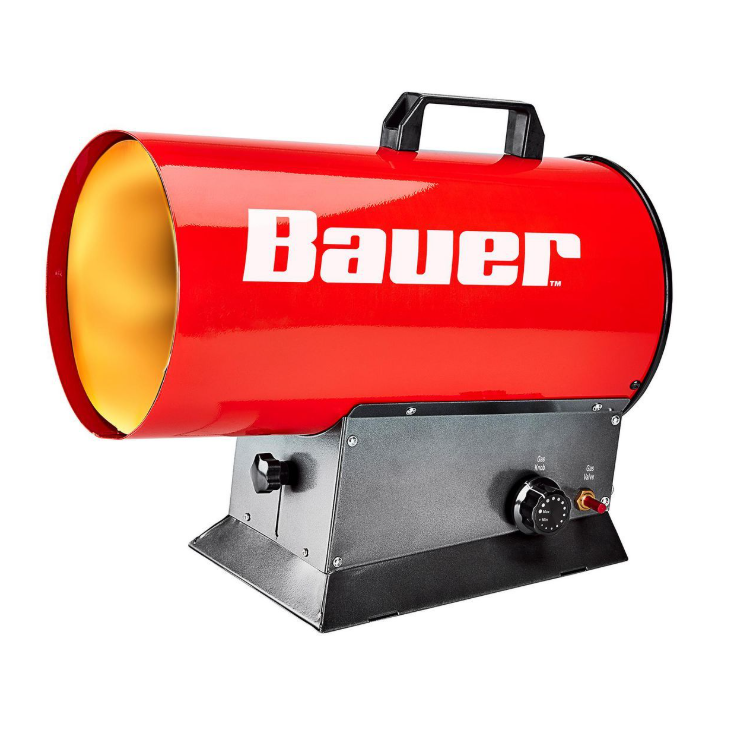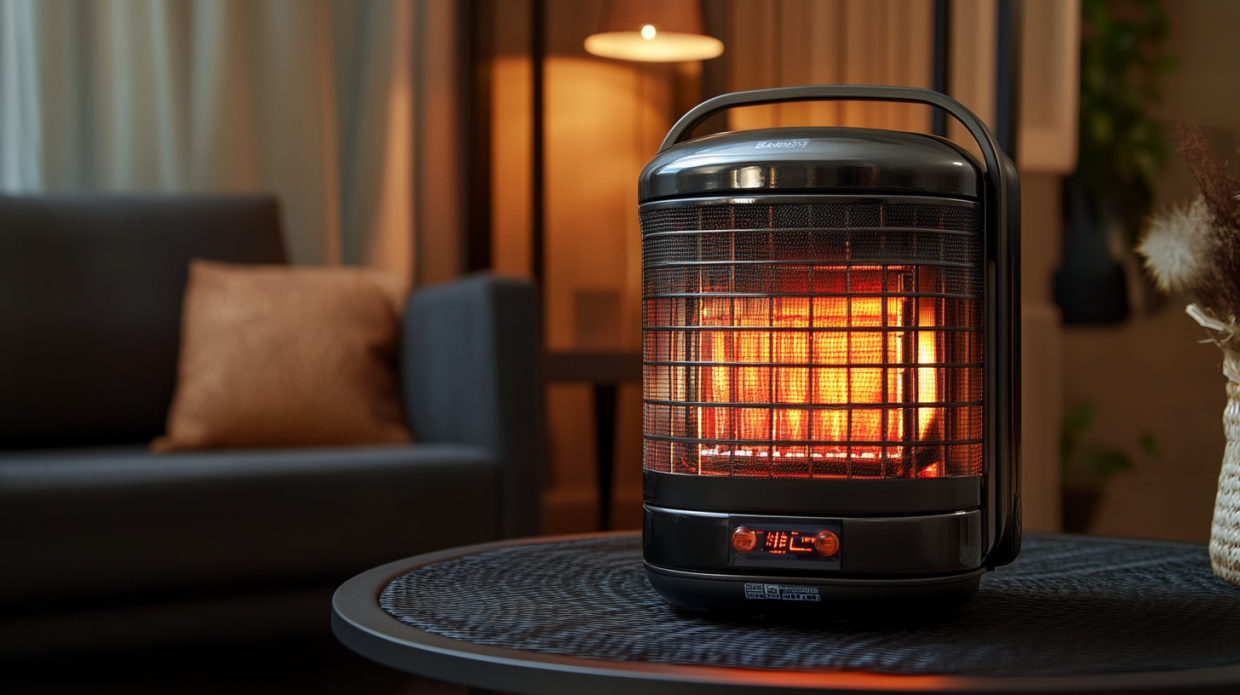
BAUER 30,000 – 60,000 BTU Forced Air Propane Portable Heater
- Operates up to 10 hours on a 20 lb. propane tank
- Quick start electrical ignition for fast heat delivery
- Variable heat control for easy temperature adjustments
- Adjustable delivery angle directs heat where needed
Warming Spaces, Transforming Places: How This Versatile Heating Solution Changes the Game
Winter’s icy grip can transform even the coziest spaces into uncomfortable cold zones. Whether you’re working in your garage, hosting a backyard gathering, or trying to keep a job site productive, finding the right heating solution makes all the difference. Among the myriad options available, the Bauer propane heater stands out as an exceptional balance of power, portability, and value that deserves serious consideration for anyone facing the challenge of heating spaces efficiently.
As someone who’s spent countless hours in workshops and outdoor spaces during brutal winter months, I’ve come to appreciate the difference a reliable heater makes. Not just in terms of comfort, but in productivity, enjoyment, and even safety. Let’s dive deep into everything you need to know about this increasingly popular heating solution.
Understanding the Basics: What Sets Bauer Propane Heaters Apart
The Bauer propane heater has gained traction among DIY enthusiasts, professionals, and homeowners alike for good reason. At its core, it’s a portable heating solution that transforms liquid propane into powerful, reliable heat. But what exactly makes it worth considering over other options?
First, let’s talk power. The Bauer propane heater typically delivers an impressive 60,000 BTU output, placing it firmly in the high-performance category of portable heaters. This substantial output can effectively heat spaces up to 1,500 square feet, making it suitable for everything from modest workshops to larger garages or outdoor gathering areas.
The design prioritizes portability without sacrificing durability. Weighing approximately 15 pounds (without the tank), the unit features a sturdy carry handle that makes relocating it straightforward. This balance of power and portability represents one of the model’s strongest selling points – you’re not sacrificing heating capacity for the sake of movement, nor are you anchored to a fixed location like with many high-output heating systems.
Price Point and Purchasing: Getting the Best Value
When it comes to investment, the Bauer propane heater hits a sweet spot in the market. Currently priced at approximately $119.99, it offers significant heating capability without breaking the bank. This positions it as a mid-range option that delivers premium performance – essentially providing professional-grade heating at a consumer-friendly price point.
For those tracking price trends, it’s worth noting that seasonal sales often bring this price down further. Winter clearance sales in late February or early March can sometimes see discounts of 15-20%, while pre-season sales in September might offer similar savings opportunities.
As for where to purchase, Harbor Freight stands as the primary authorized retailer for Bauer products, including their propane heater. This exclusive distribution approach helps maintain quality control and ensures buyers receive authentic products backed by the manufacturer’s warranty. Harbor Freight’s widespread physical locations across the country make in-person purchasing convenient, while their online store offers nationwide shipping options.
Occasionally, you might find Bauer propane heaters through secondary marketplaces or resellers, but purchasing directly from authorized retailers ensures you’ll receive full warranty coverage and customer support.
Technical Specifications: Understanding the Performance Details
The heart of any heater’s performance lies in its technical specifications, and the Bauer model impresses in several key areas:
The 60,000 BTU rating places it among the more powerful portable propane heaters on the market. For context, many competing portable models offer between 30,000-45,000 BTUs, making the Bauer a standout in terms of raw heating power.
This output translates to approximately 1,500 square feet of effective heating area under standard conditions. However, several factors affect this range in practice, including ceiling height, insulation quality, ambient temperature, and air circulation patterns. In well-insulated spaces, the effective range might extend further, while drafty or poorly insulated areas might require positioning the heater more centrally or operating at higher settings.
The heating efficiency is enhanced by the unit’s directional design, which allows users to focus the heat output toward specific areas rather than dispersing it evenly in all directions. This targeted approach proves especially valuable in workshop settings where you might be working in a particular zone within a larger space.
Fuel Requirements and Runtime Considerations
Understanding the fuel requirements and expected runtime helps in planning practical use of the Bauer propane heater. Here’s what prospective owners should know:
The heater does not come with a propane tank included in the purchase price, which is standard practice across the industry. It’s designed to work with standard 20-pound propane tanks (the same type commonly used for gas grills), which need to be purchased separately.
In terms of consumption and runtime, at maximum output, the heater will typically consume approximately 1.4 pounds of propane per hour. This translates to roughly 13-15 hours of continuous operation from a full 20-pound tank. Operating at lower heat settings naturally extends this runtime significantly.
The connection system uses a standard POL fitting and includes a 10-foot hose, giving users reasonable flexibility in tank placement. This separation between the heat source and fuel tank represents an important safety feature that shouldn’t be overlooked.
For those planning extended use, having a backup tank on hand makes sense, particularly for job sites or outdoor events where continuous heating is essential. The quick-connect design makes tank swapping a straightforward process that can be completed in under a minute.
Portability and Design Features
The physical design of the Bauer propane heater strikes an effective balance between sturdy construction and practical portability. Standing approximately 18 inches tall with a footprint of about 14 inches square, it’s compact enough to store easily yet substantial enough to provide serious heating capability.
The unit weighs approximately 15 pounds without the propane tank attached, making it manageable for most users to carry short distances. The built-in carrying handle is positioned to balance the weight effectively, even when moving quickly between locations.
The control panel features intuitive design elements that make operation straightforward even for first-time users. The large control knob allows for precise adjustment of heat output, while the piezo ignition system eliminates the need for matches or lighters – a small but meaningful convenience, especially in windy conditions.
Construction quality appears to be a priority, with powder-coated steel housing that resists corrosion and stands up to the inevitable bumps and knocks that come with portable equipment. The base provides a stable platform that reduces tipping risk, though as with any heating equipment, placement on level surfaces remains important.
Indoor and Outdoor Versatility: Where Can You Use It?
One of the most common questions about propane heaters involves their suitability for different environments. The Bauer propane heater is designed primarily as a semi-outdoor heating solution, ideal for well-ventilated spaces like garages, workshops, partially enclosed patios, construction sites, and outdoor gatherings.
It’s critical to understand that like all propane combustion heaters, the Bauer model produces carbon monoxide as a byproduct of operation. For this reason, it’s not certified or recommended for use in fully enclosed living spaces like bedrooms, living rooms, or other primary indoor residential areas. The manufacturer explicitly warns against such use, and for good reason – carbon monoxide is odorless, colorless, and potentially lethal.
That said, the heater excels in spaces that fall into the “semi-indoor” category. Garages and workshops with proper ventilation represent ideal use cases. The key consideration is airflow – spaces with at least some form of ventilation, whether through windows, doors, or dedicated ventilation systems, can be appropriate settings for operation.
Outdoor applications showcase the heater’s versatility particularly well. From patios and decks to campsites and sporting events, the portable design and powerful output make it an excellent choice for extending outdoor season usage and creating comfortable gathering spaces even when temperatures drop.
Safety Features and Best Practices
Safety rightfully ranks as a top concern for any heating equipment, and the Bauer propane heater incorporates several important safety features that help mitigate risks:
The built-in tip-over switch automatically shuts down the unit if it’s knocked over, preventing potential fire hazards. This feature proves especially valuable in active environments like workshops or construction sites where equipment might get bumped.
An oxygen depletion sensor (ODS) monitors ambient oxygen levels and will shut down the heater if oxygen levels drop below safe thresholds. This represents a critical safeguard against one of the primary risks associated with combustion heaters.
The thermocouple flame failure device ensures that gas flow stops if the flame is extinguished, preventing unburned propane from accumulating.
Even with these built-in protections, responsible use remains essential. Best practices include:
- Always ensure adequate ventilation
- Maintain clear space (at least 3 feet) between the heater and any combustible materials
- Never leave the heater unattended while operating
- Perform regular inspections of the hose and connections for wear or damage
- Store propane tanks outdoors, never in enclosed spaces
- Follow manufacturer guidelines for startup, operation, and shutdown procedures
Operation and Usability: Getting Started
The operation of the Bauer propane heater follows a straightforward process designed to be accessible even to first-time users:
- Connect the propane hose to both the heater and the propane tank, ensuring tight connections
- Slowly open the valve on the propane tank
- Press and hold the control knob while turning to the “Pilot” position
- Push the ignition button while continuing to hold the control knob
- Once the pilot flame is established (typically visible through a small window), continue holding the knob for approximately 30 seconds
- Release the knob and turn to desired heat setting
The piezo ignition system typically delivers reliable startup without requiring matches or lighters, though carrying a long-reach lighter as backup remains good practice, particularly for outdoor use where wind might complicate the ignition process.
The heat output adjustment allows users to fine-tune the temperature based on conditions and preferences. At lower settings, the heater produces gentle, steady warmth suitable for taking the edge off cool temperatures. At maximum output, it generates significant heat that can make even cold environments workable.
The shutdown process is equally important: turn the control knob to the “Off” position, then close the valve on the propane tank to ensure complete system shutdown. Allowing the unit to cool completely before storage or transport prevents potential burns and protects internal components.
Maintenance and Longevity Considerations
Like any quality equipment, the Bauer propane heater rewards proper maintenance with extended service life. Fortunately, the maintenance requirements remain relatively modest:
Regular inspection of the hose and connections should become routine before each use. Look for cracks, wear, or damage that might compromise safety or performance. Replacement hoses are readily available should the need arise.
The burner assembly occasionally benefits from compressed air cleaning to remove dust and debris that might accumulate during storage or operation in dusty environments. This simple maintenance step helps maintain optimal flame characteristics and heating efficiency.
The ignition system occasionally requires attention if startup becomes inconsistent. Cleaning the igniter tip with fine sandpaper often resolves spark issues that might develop over time.
Proper storage significantly extends equipment life. Storing the heater in a clean, dry environment protected from extreme temperatures and moisture prevents corrosion and component degradation. Many users find that a dedicated cover helps preserve finish and protect internal elements, particularly if the unit must be stored in semi-exposed locations.
Warranty Coverage and Support
Bauer backs their propane heater with a 90-day warranty that covers defects in materials and workmanship. While this warranty period is shorter than some premium brands that offer 1-3 year coverage, it reflects the value-oriented price point of the Bauer line.
The warranty specifically covers normal residential use and requires proof of purchase, so keeping your receipt remains important. Commercial applications may have different warranty terms, so contractors should clarify coverage before deployment in professional settings.
For service and support, Harbor Freight serves as the primary contact point for warranty claims and parts replacement. Their nationwide presence means most users have reasonable access to in-person service if needed, though phone and online support options also exist for troubleshooting more minor issues.
Replacement parts availability represents another strength of the Bauer system. Common maintenance items like hoses, regulators, and ignition components remain readily available, extending the practical service life well beyond the warranty period for those willing to perform basic maintenance and repairs.
Comparative Analysis: How Does It Stack Up?
Understanding how the Bauer propane heater compares to alternatives helps in making an informed purchase decision. Here’s how it positions against key competitors:
Compared to other mid-range propane heaters like the Mr. Heater Big Buddy or Dyna-Glo models, the Bauer typically offers higher BTU output (60,000 vs. 18,000-30,000) at a competitive price point. This makes it particularly attractive for larger spaces or situations requiring rapid temperature increase.
The tradeoff comes in features – some competitors offer additional capabilities like built-in fans for improved heat distribution or multi-fuel options that the Bauer doesn’t include. The Bauer approach prioritizes raw heating power and simplicity over these supplemental features.
Against premium brands like DeWalt or Milwaukee, the Bauer comes in at roughly half the price while delivering comparable heating performance. The premium options typically justify their higher cost through longer warranties, additional safety features, or integration with broader tool ecosystems.
For most typical users – homeowners, DIY enthusiasts, and occasional contractors – the Bauer hits an effective balance point that delivers professional-grade heating capability without unnecessary features that drive up costs.
Real-World Performance and User Experiences
User experiences with the Bauer propane heater generally reflect positive outcomes, particularly when the unit is used as intended. Workshop and garage users frequently comment on the heater’s ability to raise temperatures quickly, making cold-weather projects more comfortable within minutes rather than hours.
Construction and job site users appreciate the portability and rapid heating capability, which allows work to continue in cold conditions with minimal downtime. The absence of electrical requirements proves especially valuable in new construction environments where power might not yet be established.
Outdoor enthusiasts report success using the heater for camping, tailgating, and backyard gatherings, extending the usable season for outdoor activities by months in many climates. The relatively quiet operation compared to forced-air alternatives earns particular praise in these social settings.
Common criticisms typically center on the startup process, which some users find less intuitive than electronic-ignition systems, and the absence of a built-in fan for heat circulation. Neither represents a fundamental flaw, but rather reflects the design priorities and price point of the model.
Environmental Considerations and Efficiency
From an environmental perspective, propane heaters like the Bauer model offer several advantages over alternatives, particularly when compared to older heating technologies. Propane burns cleaner than many fossil fuels, producing fewer particulates and lower carbon monoxide levels than kerosene or oil-based heating systems.
The portability and zone-heating approach also contribute to efficiency by allowing users to heat only the spaces currently in use rather than entire structures. This targeted heating strategy can significantly reduce overall fuel consumption compared to whole-building heating systems, particularly in larger environments like workshops or garages where activity might be concentrated in one area.
For those concerned about emissions, proper maintenance plays a crucial role in ensuring clean combustion. Regular cleaning and adjustment of the burner assembly helps maintain optimal air/fuel mixture, which directly impacts both efficiency and emissions profile.
Conclusion: Is the Bauer Propane Heater Right for You?
After exploring the various aspects of the Bauer propane heater, the key question remains: does it match your specific needs? The answer depends largely on your intended use case and priorities.
If you’re seeking powerful, portable heating for garages, workshops, job sites, or outdoor gatherings, the Bauer propane heater offers compelling value. The combination of 60,000 BTU output, reasonable portability, and accessible price point makes it an excellent choice for those needing significant heating capability without permanent installation.
The absence of electrical requirements adds versatility for remote locations, power outage scenarios, and new construction environments. The straightforward design prioritizes reliability and simplicity, making it accessible even to those with limited technical experience.
However, those seeking primary indoor heating solutions should look elsewhere – the Bauer, like all combustion propane heaters, isn’t designed or certified for use in enclosed living spaces. Similarly, if ultra-quiet operation or premium features like remote control or programmable settings rank as top priorities, more specialized (and typically more expensive) alternatives might better align with those needs.
For most practical applications in semi-indoor and outdoor environments, the Bauer propane heater delivers exceptional performance at a reasonable price point. Whether you’re finishing a winter workshop project, hosting an outdoor gathering when temperatures drop, or maintaining productivity on cold-weather job sites, this versatile heating solution deserves serious consideration. With proper use and maintenance, it promises to transform uncomfortable cold spaces into productive, enjoyable environments regardless of what the thermometer says.

